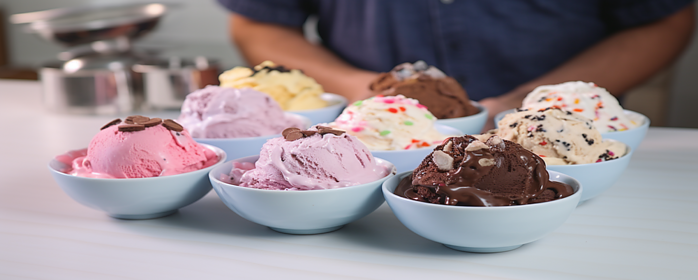
I’m going to take you on a whirlwind tour of ice cream’s past—a journey of taste and time. Ice cream isn’t just a summer treat; it’s a cultural artifact that’s been cooling palates for centuries. Have you ever wondered how this sweet concoction came to be? Well, guess what? You’re going to find out about its transformation from an elite delicacy to a household staple.
The story of ice cream begins in ancient times. Records suggest that the Chinese were the first to create a frozen mixture of milk and rice. This isn’t just about exotic flavors; it’s also about trade and exploration, as these methods reached Europe through the Silk Road. Aristocrats in the Roman Empire and later during the Renaissance indulged in ice cream’s ancestor, made from snow and mixed with fruits and nuts.
Now, let’s talk evolution. The transition from hand-cranked methods to contemporary machines reflects not just technological advancements but also changes in social status. Ice cream making started with labor-intensive methods that only the wealthy could afford and has evolved into an accessible treat thanks to industrialization.
But this evolution isn’t just important for its history…it’s vital for understanding the nuances and depth of the craft.
Why does this matter?
Because traditional methods have paved the way for the diverse world of ice cream we enjoy today, influencing both flavor and texture.
I’m here to help you appreciate the craft that goes into every scoop of traditional ice cream. Now, why does that matter for our next section? Because understanding the roots of ice cream provides the groundwork to master the art of making it. And that’s going to include demystifying the process of churning, choosing the right ingredients, and revealing how to get that perfect creamy consistency. So here’s to the delicious history of ice cream, setting the stage for the timeless method of churning that still captivates ice cream lovers around the globe.
Classic Churn: Mastering the Art of Traditional Ice Cream Making
You’re probably familiar with the iconic image of an old-fashioned ice cream maker that looks like a wooden bucket with a handle on top. This is the traditional churn, and it’s not just a piece of nostalgia; there’s a reason it’s stuck around. I’m going to explain the importance of this method and how it shapes the ice cream we’ve come to love.
Let’s start by addressing the traditional way to make ice cream. It’s all about the ingredients and preparation. First, you’ll need cream, milk, sugar, and your chosen flavorings. These are whisked together to form your base. Then comes the ice and salt mixture, crucial for lowering the freezing point and making the magic happen.
Customizing your ice cream is one of the joys of traditional churning. Maybe you’re going to experiment with vanilla beans directly from Madagascar, or perhaps you’ll add fresh seasonal fruit. This method allows you to play with ingredients in a way that most automated processes don’t.
You might wonder why bother with this method when machines can do the work for you. The answer lies in the texture. Churning slowly introduces less air, resulting in denser and creamier ice cream. Plus, the hands-on approach can make for a fun family activity or a satisfying DIY project.
Before you know it, you’re going to see and taste the difference. You can always adjust your approach down the road, but mastering this method can be a delightful skill. There’s something incredible about digging into a batch of homemade ice cream that YOU churned. The ice cream from this method tastes like accomplishment – and, of course, deliciousness.
Modern Marvels: Exploring Contemporary Ice Cream Machines
If you’re intrigued by the notion of making ice cream a little less labor-intensive than the classic churn method, you’ll be glad to know that there’s a slew of modern machines at your disposal. These gadgets range from basic models that require pre-freezing to fully automated ice cream stations that can churn out gourmet-quality treats at the press of a button.
When you’re choosing a modern ice cream maker, consider the capacity, speed, ease of use, and of course, the price.
(1) Countertop electric ice cream makers are the most commonly used today, and they’re a great way to dip your toes into the world of homemade ice cream without too much commitment.
These machines work by spinning the ice cream base while simultaneously freezing it, typically with the help of a frozen bowl or a built-in freezing system. Some more advanced models even allow you to control the churn speed, which affects the ice cream’s texture and airiness.
I’ve taken a look at some of the top-rated machines out there. Reviews often mention how they appreciate the convenience of not having to hand crank and how much they enjoy the speed with which they can make batches of ice cream.
Some models, such as the Cuisinart ICE-70, are frequently highlighted for their ease of use and consistent results.
While the advances in ice cream technology might make you think the older methods are obsolete, the next section will introduce you to the world of no-churn ice cream. This method, believe it or not, requires no specialized equipment at all.
DIY Ice Cream Without the Gadgetry: No-Churn Methods
I’m going to walk you through the magic of no-churn ice cream and how this simplified method is perfect for an impromptu dessert. If you’ve ever thought machine-made ice cream was your only option, think again.
First things first, let’s break down the science. No-churn ice cream works because of the way fat, air, and freezing temps come together to create a creamy texture. Once you beat the heavy cream and fold in condensed milk and your choice of flavorings, you’re basically a freezer away from indulgence.
You’re going to find out about a variety of no-churn recipes. Choose something that resonates with you — whether that’s a classic vanilla bean, a bold espresso swirl, or a fruit-packed sorbet.
I’m not just giving you a recipe; I’m here to help you transform your approach to homemade desserts. With just a few tips, you can create no-churn ice cream that rivals any traditional method.
Do you love trying out new food projects?
Then you’ll appreciate the simplicity and flexibility of making ice cream without a churn. You can always adjust your approach down the road, experimenting with exotic additives or different sweeteners.
You’re likely curious about how no-churn compares in texture and quality to churned ice cream. Interestingly enough, many folks can’t tell the difference! No-churn ice cream can be just as creamy, with the right technique.
I really hope that you embrace the insights and take the plunge into making no-churn ice cream. Don’t worry too much about perfection on your first attempt. Ice cream is forgiving, and every batch is a chance to refine your craft.

This article was very informative! I’ve always wondered about the different methods of making ice cream. I’m curious, though, if there’s a significant difference in taste or texture between ice cream made using a traditional churn and the newer, faster methods? Also, are there any unique or lesser-known techniques that might be worth trying at home?
The taste difference won’t be too stark, but the consistency of the ice cream will be different. The newer churn methods will usually be a little smoother, while the consistency of the hand methods will be a little more textured. So it really depends on the outcome you are after.
And definitely do try at home! 🙂